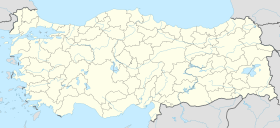Ophryneion
Ὀφρύνειον | |
| Location | İntepe, Çanakkale Province, Turkey |
|---|---|
| Region | Troad |
| Coordinates | 40°1′22″N 26°20′6″E / 40.02278°N 26.33500°E |
| Type | Settlement |
| History | |
| Founded | 6th century BC |
| Periods | Archaic Greece to Byzantine Empire |
Ophryneion or Ophrynium (
romanized: Ophryneion) was an ancient Greek city in the northern Troad region of Anatolia. Its territory was bounded to the west by Rhoiteion and to the east by Dardanus. It was located about 1.5 km north-east of the village of İntepe (previously known as Erenköy) in Çanakkale Province, Turkey.[1] The city was situated on the steep brow of a hill overlooking the Dardanelles, hence the origin of its Ancient Greek name ὀφρῦς (ophrus), meaning 'brow of a hill', 'crag'.[2]
Foundation
Ophryneion was supposedly one of a series of cities founded by
surface surveys conducted on the site suggest that it was occupied no earlier than the 6th century BC.[6]
Tomb of Hector
Dionysos
holding bunch of grape, OΦPYthis bronze coin was struck in Ophryneion 350–300 BC
In antiquity, Ophryneion was considered to be the site of the tomb of
Thebes prosperity should this happen.[9] In the early 1st century AD, the geographer Strabo described there being a sacred precinct of Hector near Oryphneion in a conspicuous spot, but scholars have been unable to identify it.[10]
History
Ophryneion is rarely mentioned in extant sources from Antiquity.
Thebes (see above, The Tomb of Hector), although Strabo's description of Hector's precinct at Ophryneion in the 1st century AD suggests that he was still worshipped there after his bones had moved.[16] Strabo indicates that before the Treaty of Apamea in 188 BC, Ophryneion had been under the sway of Dardanus to the north-east, whereas after this point it instead belonged to Ilium.[17] Pot sherds and coins found at Ophryneion indicate that the site was continuously occupied until at least the Byzantine period, but with the exception of its fame as the one-time location of the bones of Hector, we hear no more about it.[18]
References
- ^ Cook (1973) 72–7 with Fig. 3.
- LSJs.v. ὀφρῦς A.2.II.
- ^ Scholia in Euripides, Andromache 10.
- ^ Lysimachus of Alexandria, Nostoi, BNJ 382 F 9; see A. Schachter, 'Biography', BNJ (= Brill's New Jacoby) 382.
- ^ B.C. Rose, 'Separating fact from fiction in the Aiolian migration' Hesperia 77 (2008) 419. An example of the opposing tradition is Hellanicus FGrHist 4 F 31 = Dionysius of Halicarnassus, Roman Antiquities 1.46.1, 47.2, which associates the people of Ophyneion with Aeneas' escape from Troy.
- ^ Cook (1973) 77.
- .
- ^ B.V. Head, Historia Numorum2 547, SNG Cop. Troas 455–60.
- 31.502.
- ^ Strabo 13.1.29; Cook (1973) 77. In the summer of 399 BC Xenophon sacrificed at Ophryneion, but he does not say to which deity: Xenophon, Anabasis 7.8.5.
- ^ Herodotus 7.43.2.
- ^ IG I3 71.III.131 (restored), IG I3 77.IV.20 (restored). The restored tribute assessment of 5 talents is considered suspiciously high: Cook (1973) 77, Carusi (2003) 37.
- ^ IG I3 430.11.
- ^ Xenophon, Anabasis 7.8.5.
- ^ Demosthenes 33.20. For the speech's authenticity (often doubted), see D. MacDowell, Demosthenes the Orator (2009) 275–9.
- ^ Strabo 13.1.29.
- ^ Strabo 13.1.39, Cook (1973) 77.
- ^ Cook (1973) 74–7.
Bibliography
- J.M. Cook, The Troad (Oxford, 1973) 72–7.
- C. Carusi, Isole e Peree in Asia Minore (Pisa, 2003) 37.
- S. Mitchell, 'Ophryneion' in M.H. Hansen and T.H. Nielsen (eds.), An Inventory of Archaic and Classical Poleis (Oxford, 2004) no. 786.

